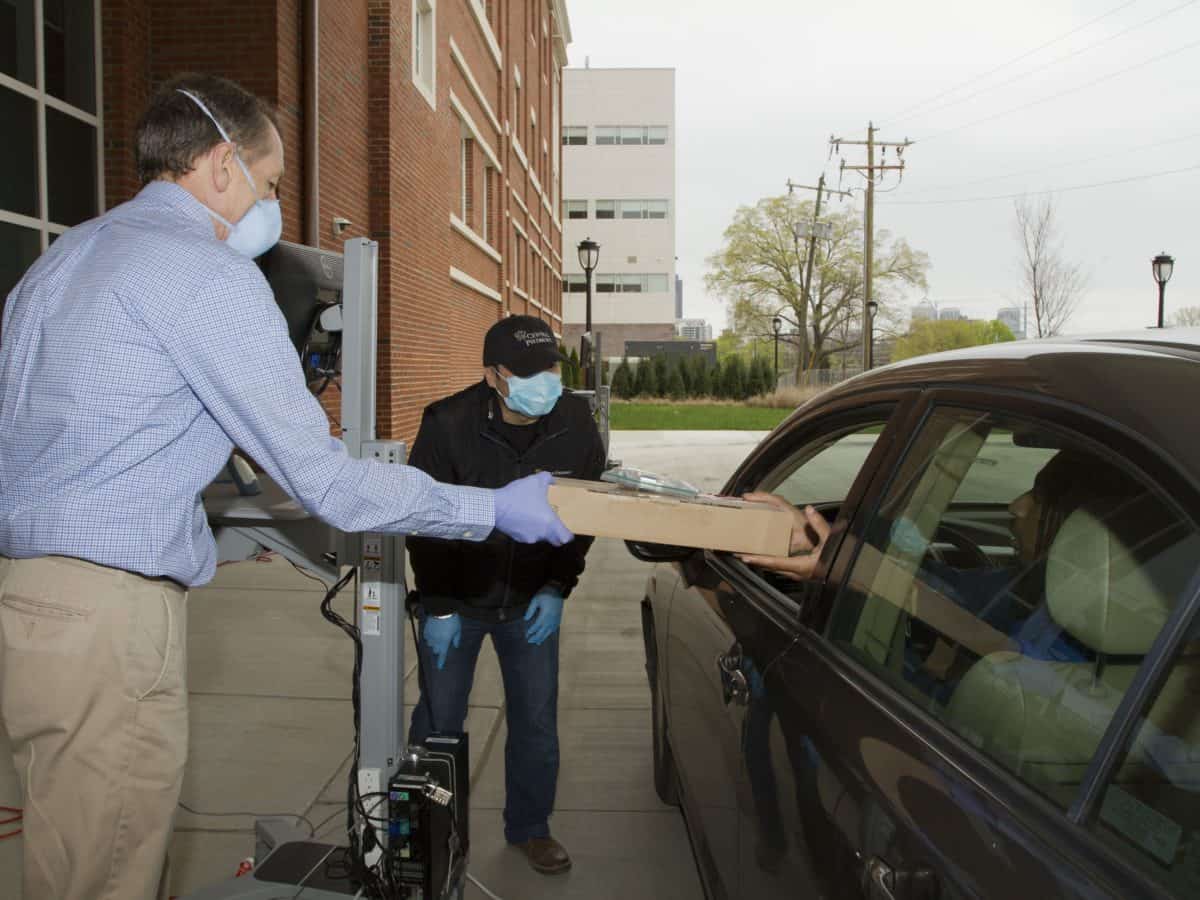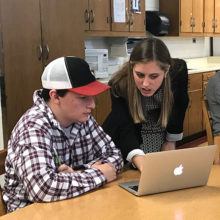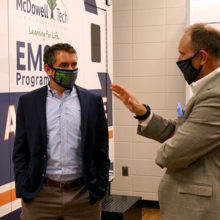
North Carolina’s 58 community colleges will collectively receive $60 million to provide emergency financial aid to students thanks to the federal Coronavirus Aid, Relief, and Economic Security (CARES) Act. But the Department of Education’s interpretation of Congress’s intent in deciding who is eligible for help is bringing criticism from some campus leaders.
Signed on March 27, the CARES Act provides almost $14 billion to postsecondary education students and institutions across the country. Of that $14 billion, a little less than half ($6.28 billion) must go to students “for expenses related to disruptions to their educations due to the COVID-19 outbreak, including things like course materials and technology as well as food, housing, health care, and childcare.” The other half of the funding is for institutional costs.
To receive the student aid funding, colleges first have to submit an application and receive approval from the Department of Education. Many North Carolina community colleges have submitted that application and have been approved or are waiting to be approved. The table below shows how much each North Carolina community college will receive, including how much must go to students as financial aid grants.
Colleges must give the funding directly to students, and they have one year to spend the funds. They are required to file reports to the federal government 30 days after they receive approval and every 45 days after that. These reports must document how the college is distributing funds to students, the amount of each student grant, and any instructions provided to students.
So, which students are eligible to receive these cash grants, and how are community colleges determining how much to give to students? Each college is figuring out their own system for distributing the money, but all have to follow the guidelines from the Department of Education.
Who is eligible for the student financial aid grant funding?
Only certain community college students are eligible to receive these financial aid grants. In a Frequently Asked Questions document released two weeks after the initial funding announcement, the Department of Education stated: “Only students who are or could be eligible to participate in programs under Section 484 in Title IV of the Higher Education Act of 1965, as amended (HEA), may receive emergency financial aid grants.”
What that means is students must be a U.S. citizen or eligible noncitizen, have a valid Social Security number, be registered with the Selective Service (if male), and have a high school diploma or GED. Students who were only enrolled in online courses as of March 13 are not eligible to receive the grants.
These requirements have come under fire from higher education institutions and advocates because many students, especially those attending community colleges, are not eligible. On May 11, the California community college system filed a lawsuit against Secretary Betsy DeVos seeking to declare the eligibility requirements unconstitutional and unlawful and halt their implementation.
California Community Colleges Chancellor Eloy Ortiz Oakley said: “The Department of Education ignored the intent of the CARES Act to give local colleges discretion to aid students most affected by the pandemic, and instead has arbitrarily excluded as many as 800,000 community college students. Among those harmed are veterans, citizens who have not completed a federal financial aid application, and non-citizens, including those with DACA status.”
Others have critiqued the guidelines for being framed around the experience of students at four-year institutions.
“The [Department of Education] guidance disallowed emergency aid to students with 100% online course loads. The presumption these students were not impacted by our campuses closing is false,” explained Dale McInnis, president of Richmond Community College. “They were deeply affected by the reduction or elimination of student support services, test proctoring, and in many cases, access to technology. Child care, housing, and food issues were not restricted to face-to-face students alone, and those in all online courses deserved some consideration for aid.”
“We are grateful for the funding,” McInnis continued, “but I would hope in the future, community college leaders and our stakeholder organizations will be afforded the opportunity for input in how funds can be better aligned between federal policy and the real and urgent needs of our students and colleges.”
Forsyth Technical Community College President Janet Spriggs agreed, stating, “Online students have also lost their jobs, are also caring for young children or elderly family members, and also need support and assistance during this unprecedented time. There are other rules and regulations that exclude other students. We are using our Foundation and other funding to build programs to fill the gap for students who do not meet eligibility requirements for the CARES Act funding.”
The difference between the CARES Act language and the more restrictive eligibility requirements from the Department of Education led to confusion and a delay in colleges applying for the funding.
“It seemed like it was one thing before they released the particulars,” said Rachel Desmarais, president of Vance-Granville Community College. “And then some of the FAQ language that was released almost went counter to what we heard it was going to be or what it said.”
“I think there was a little intimidation and fear, in a way, just because many colleges know that if you don’t handle Title IV exactly right, then you will owe the Department of Education, plus interest,” Desmarais said. “So anytime you’re dealing with the Department of Ed, there’s the desire to get the rules set so you know what you’re dealing with, and that comfort level with this speed and haste, which I certainly understand, wasn’t there.”
One way for colleges to guarantee that students are eligible to receive the funding is to require students to fill out the Free Application for Federal Student Aid (FAFSA).
“The language says that students have to be eligible for Title IV funding,” Desmarais said. “The only way we know to do that is to have them file or complete a 2019-2020 FAFSA.”
Related reading
How colleges are allocating student aid
Individual colleges have the opportunity to design their own process and model for delivering the student aid portion of the CARES Act as long as they follow the Department of Education guidelines for eligibility and reporting.
As community colleges considered their options for distributing the student aid, they weighed a variety of approaches, according to our conversations with presidents and administrators across the state.
Some colleges decided on an equal disbursement to all eligible students on the assumption that every individual faced some level of disruption from COVID-19.
Asheville-Buncombe Technical Community College (A-B Tech) was one such institution. Almost 2,300 students at A-B Tech applied for financial aid during the 2019-2020 school year and were enrolled as of March 9. Each of those students will receive an equal share of the student aid funding.
“Some colleges will use other processes, such as a sliding scale tied to number of hours enrolled,” said A-B Tech Interim President Joseph Barwick. “Others will tie it to demonstrated need. At A-B Tech, we believe the money was intended for students to use for living expenses, such as rent, power, and groceries, to help them during this time of crisis. We also believe it is not our role to attempt to determine which students were hurt the most or whose lives are most precarious. Therefore, we accept the DOE gesture in the spirit we believe it was offered and hope it provides some relief to the students who receive it.”
Barwick told us the college will use the promise of funds to appeal to nearly 2,000 A-B Tech students who have not yet filled out a FAFSA to complete the form.
Other institutions decided to take a hybrid approach.
Caldwell Community College and Technical Institute (CCC&TI) will distribute $300 to all students who have completed the FAFSA and/or Title IV eligibility verification items. CCC&TI will then use an application for their remaining funds.
Central Piedmont Community College (CPCC) decided to frame their student aid disbursement process around three key tenets:
- Need: Every eligible student receives an award based on their Expected Family Contribution (EFC). The lower the EFC, the higher their need. Every eligible student will get an emergency grant until funds are exhausted.
- Equity: Individual award amounts are commensurate with each student’s need. EFC is a measure of financial need calculated by the Department of Education and accounts for income, assets, benefits (such as unemployment or Social Security), family size, and other factors.
- Objectivity: Follows federal guidelines with few local restrictions and clear justification for our approach that strive to eliminate the risk compliance and audit exceptions.
Kandi Deitemeyer, president of CPCC, noted that nearly 32,000 students at the college are not eligible due to being a Career and College Promise student, Deferred Action for Childhood Arrivals (DACA), or other classifications that mean they are not eligible for funds under the Department of Education guidance.
“Central Piedmont will award funds two ways – formula and application,” Deitemeyer said. “This dual approach ensures that Central Piedmont maximizes awards to all students that meet the eligibility criteria, while targeting funding to students with greater financial need regardless of the reason for their need. Some students may be single parents, others may have lost their job. Allowing students to identify and document their individual financial needs ensures Central Piedmont is not prioritizing one high-need group over another.”
Vance-Granville Community College is using a hybrid approach that combines need, based on a student’s Expected Family Contribution and the amount of hours students are taking. For those students with the greatest need (with an Expected Family Contribution of $0), full-time students will receive $1,250, three-quarter time students will receive $1,000, half-time students will receive $750, and less than half-time students will receive $500. To receive the aid, students must have completed a FAFSA and complete a short online application.
“It’s a tried and true method,” Desmarais said of her college’s decision to use Expected Family Contribution to determine student need. “We’re going to let students tell us what they need it for. We felt this is the best way, based on the EFC, to not have to get involved in the particulars of each individual student.”
Other institutions decided to allocate their funding through an application-based process.
Pitt Community College (PCC) notified eligible students of the emergency aid availability and received more than 1,900 applications.
According to PCC Financial Aid Director Lee Bray, a team of financial aid and grants management staff reviewed the applications and awarded $2.7 million to assist students with expenses the coronavirus created by disrupting campus operations.
The PCC framework stated that eligible expenses include expenses for food, housing, course materials, technology, health care, and child care.
“The top emergency requests were for food (68% of respondents) and technology (44%),” said Julie Crippen, PCC’s director of grants management. “This has also led to the college organizing a food pantry pick up for students.”
These and other student aid models are now being implemented at colleges across the state. Some colleges have already mailed out the first wave of checks.
As policymakers and agencies consider future action to benefit the most vulnerable students, community college leaders stressed the importance of being included in the conversation.
“I was very disheartened last week to see that community college presidents and chief executives were not included in the meeting with leaders from universities across the country and the Vice President and Secretary of Education,” said Spriggs. “In my opinion, we should have had a seat at the table because our students are important and our needs are not the same. We deserve the opportunity to have a voice and inform changes to current policy and/or new policy.”




